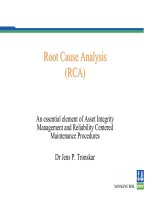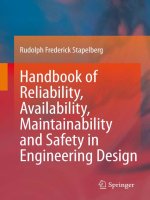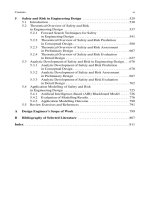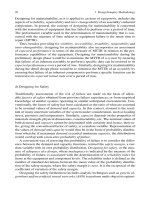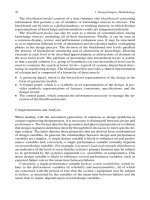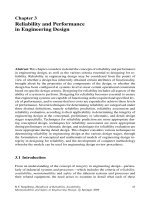HANDBOOK OF SOLID WASTE MANAGEMENT AND WASTE MINIMIZATION TECHNOLOGIES
Bạn đang xem bản rút gọn của tài liệu. Xem và tải ngay bản đầy đủ của tài liệu tại đây (23.09 MB, 491 trang )
H A N D B O O K OF
SOLID W A S T E M A N A G E M E N T AND
WASTE MINIMIZATION TECHNOLOGIES
This Page Intentionally Left Blank
H A N D B O O K OF
SOLID W A S T E M A N A G E M E N T A N D
WASTE MINIMIZATION
TECHNOLOGIES
Nicholas P. Ch e re misinof f , Ph.D.
N&P Limited
I~UTTE
E I N
W
RWO
RTH
E M A N N
An i m p r i n t of Elsevier Science
Amsterdam Boston London New York Oxford Paris
San Diego San Francisco Singapore Sydney Tokyo
Butterworth-Heinemann is an imprint of Elsevier Science.
Copyright 9 2003, Elsevier Science (USA). All rights reserved.
No part of this publication may be reproduced, stored in a retrieval system, or
transmitted in any form or by any means, electronic, mechanical, photocopying,
recording, or otherwise, without the prior written permission of the publisher.
Recognized the importance of preserving what has been written, Elsevier Science
prints its books on acid-free paper whenever possible.
Library of Congress Cataloging-in-Publication Data
Cheremisinoff, Nicholas P.
Handbook of solid waste management and waste minimization technologies /
by Nicholas P. Cheremisinoff.
p. cm.
Includes bibliographical references and index.
ISBN 0-7506-7507-1 (alk. paper)
1. Refuse and refuse disposal. 2. Waste minimization. I. Title.
TD791 .C364 2003
628.4'4-dc21
2002034547
British Library Cataloguing-in-Publication Data
A catalogue record for this book is available from the British Library.
The publisher offers special discounts on bulk orders of this book.
For information, please contact:
Manager of Special Sales
Elsevier Science
200 Wheeler Road, 6 th Floor
Burlington, MA 01803
Tel: 781-313-4700
Fax: 781-313-4880
For information on all Butterworth-Heinemann publications available, contact our
World Wide Web home page at:
1098765432
1
Printed in the United States of America
CONTENTS
Preface, vii
About the Author, xi
Chapter 1. Source Reduction and Waste Minimization, 1
Introduction, 1
Future and Long-Term Liabilities, 2
The Hierarchy of Waste Management, 3
The Principles of Life Cycle, 6
Costs of Environmental Management, 8
P2 and Waste Minimization at Work, 14
A Short Review, 21
Chapter 2. Environmental Laws and Regulatory Drivers, 23
Introduction, 23
NEPA, 24
RCRA, 24
Clean Air Act, 26
Clean Water Act, 26
CERCLA, 26
Emergency Planning and Community Right-To-Know Act, 27
Superfund Amendments and Reauthorization Act, 28
National Contingency Plan, 29
Oil Pollution Act, 30
Federal Insecticide, Fungicide, and Rodenticide Act, 31
Occupational Safety and Health Act, 31
Pollution Prevention Act, 31
Safe Drinking Water Act, 32
Toxic Substances Control Act, 32
A Short Review, 32
Chapter 3. Municipal Solid Waste, 34
Introduction, 34
The Composition of Municipal Waste, 35
Waste Volume Growth Trends, 37
Waste to Energy, 39
Composting, 66
Waste Management through Resource Recovery, 80
A Short Review, 87
Recommended Resources, 92
Chapter 4. Landfill Operations and Gas Energy Recovery, 96
Introduction, 96
Regulatory Considerations, 98
The Composition of Landfill Gas, 101
Landfill Design Considerations, 103
Flaring Practices, 118
Landfill Gas Energy Systems, 120
Noncombustion Technologies, 125
A Short Review, 127
Recommended Resources, 128
Chapter 5. Volume Reduction Technologies, 130
Introduction, 130
Size Reduction, 130
Concentrating Methods, 133
Incineration of Municipal Sludge, 147
Industry Approaches to Sludge Volume Reduction, 162
A Short Review, 168
Recommended Resources, 169
Chapter 6. Biosolids Technologies and Applications, 174
Introduction, 174
General Information and Background, 174
Public Issues Concerning the Use of Biosolids, 175
Biosolids Treatment, 181
Applications, 183
A Short Review, 186
Recommended Resources, 186
Chapter 7. Industry Practices, 188
The Chemical Industry, 188
Petroleum Refining, 208
Aluminum Manufacturing, 249
Iron and Steel, 258
Lead and Zinc Smelting, 278
Nickel Ore Processing and Refining, 283
Copper Smelting, 287
A Short Review, 290
Chapter 8. Establishing P2 and Waste Minimization Programs, 291
Introduction, 291
P2 Drivers, 292
Developing a P2 Program, 293
Application of Life-Cycle Tools, 316
A Short Review, 334
Recommended Resources, 336
Glossary of Environmental and Waste Management Terms, 337
Index, 466
vi
PREFACE
This volume covers the practices and technologies that are and can be applied to
the management and prevention of solid waste. It is the third volume in a series
that focuses on approaches to improving environmental performance in a costeffective manner. Earlier volumes in this Butterworth-Heinemann series are the
Handbook of Water and Wastewater Treatment Technologies and Handbook of
Air Pollution Prevention and Control. In addition, the book Green Profits: The
Manager's Handbook for ISO 14001 and Pollution Prevention establishes much
of the foundation for and philosophy behind these volumes.
The current volume is intended to provide engineers, environmental managers,
and students with a survey of the technologies and strategies for reducing solid
waste generation, and in applying resource recovery, and waste-to-energy
techniques. Discussions focus on both municipal and industrial solid wastes. The
interdependency of pollution and waste media cannot be readily distinguished, so
in many instances relationships between waste management and pollution control
and prevention strategies for air and water are included in topical discussions.
There are eight chapters to this volume. Chapter 1 provides a general overview
of the principles behind source reduction and waste minimization. Although
differences between the strategies behind pollution prevention (P2) and waste
minimization are pointed out, they are so closely linked that both subjects are
treated interchangeably at times throughout the book. Chapter 2 provides a broad
overview of the U.S. environmental statutes and liabilities associated with
environmental management. Although the focus is on solid waste, it would be
foolish to consider only those regulations that deal with this pollution medium.
All regulations dealing with the environment and public safety have a bearing on
solid waste management, particularly regulated hazardous chemicals.
Chapter 3 focuses on the problem of municipal solid waste. This is a worldwide
problem that impacts on the very sustainability of mankind and on the
preservation of Mother Earth's natural resources. Scientific studies imply that the
rate at which natural resources are being consumed exceeds the growth in
renewable resources by nearly 20%. This means that our lifestyles and those of
emerging nations and countries in transition which are improving their quality of
life rapidly are unsustainable over the next several generations. A major
philosophical change is needed in how we design and use products in our
everyday lives, as well as how we view and manage wastes. We may look at
solid waste as an enormous management issue that requires huge financial
resources to address, or we can view the horrendous volumes of wastes as a
source of renewable energy and materials recovery.
Chapter 4 discusses landfill operations and focuses on gas energy recovery.
Landfilling operations are the final disposal of solid wastes. The practice should
be viewed plain and simply as a practice that is uneconomical. It requires
vii
enormous effort, it has many hidden costs, it limits land redevelopment
opportunities, and it poses indefinite health threats. Despite these shortcomings,
it is the most widely practiced strategy for solid waste disposal worldwide. As a
strategy for both industry and municipalities, it should be discouraged and phased
out.
Chapter 5 provides an overview of solid waste volume reduction technologies. To
reduce the costs for waste disposal, investments in these technologies are needed.
These reduce waste transport and disposal fees and facilitate waste handling
operations. They supplement landfilling operations, and hence, they are
uneconomical from a broad sense of waste management strategies. These
represent treatment technologies or in some cases they are control or end-of-pipe
treatment technologies. They have high capital investments and long-term
operation and maintenance costs, plus they are energy consumers. Until
landfilling and incineration practices are phased out, these technologies are
essential. Their one advantage is that they can be applied in P2 and waste
minimization solutions, especially in developing refuse-derived fuels or in
resource recovery and recycling applications.
Chapter 6 provides and overview of biosolids applications. This is a strategy that
converts municipal sludges into soil conditioners and fertilizers. Although touted
as a green technology by EPA, in many ways it still represents a treatment
strategy. The volume of municipal sludge generated by POTWs makes this an
essential post-treatment technology. More than 11% of the biosolids generated
presently in the United States still winds up in landfills, and further there is
significant resistance on the part of many communities using this strategy.
Biosolids applications do make sense; however, it is wrong to imply that this is a
green technology. There are disadvantages, and further, the economics must
make sense in order for this to be applied as an effective waste management
strategy.
Chapter 7 provides a summary of industry sources of waste and pollution, along
with general practices and strategies for environmental management. It is
intended to provide the reader with a general reference on industry strategies and
an appreciation of the broad range of problems that industry deals with. Where
appropriate, specific solid waste handling strategies are discussed.
Chapter 8 covers the topic of establishing pollution prevention and waste
minimization programs. In order for these to be effective, they must be
implemented as formalized, dedicated programs. This is best accomplished
through an environmental management system or EMS. For discussions on how
an EMS and P2 work hand in hand, the reader should refer to Green Profits.
Chapter 8 expands on the principles of environmental cost accounting methods
presented in Green Profits by discussing the use of life-cycle costing methods.
These calculation methods are standard tools used to assess the merits of any type
of investment. They are most appropriate for devising waste management
strategies because they enable one to select the least costly technologies. Waste
viii
management represents a long-term investment, and as such, cost considerations
are a critical consideration.
A key feature of this volume is the glossary provided at the end. The glossary
contains more than 1000 terms and can serve as a handy reference for the reader
in addressing waste management issues.
Nicholas P. Cheremisinoff
ix
This Page Intentionally Left Blank
ABOUT THE AUTHOR
Nicholas P. Cheremisinoff is an industry consultant specializing in pollution
prevention and environmentally responsible care issues. He has more than 20
years of experience in applied research, manufacturing, and international project
management, and has worked extensively throughout Russia, parts of Central and
Eastern Europe, Korea, Latin America, and the United States. He has assisted
and implemented projects for the World Bank Organization, the U.S. Department
of Energy, the U.S. Trade and Development Agency, the U.S. Export and
Import Bank, the U.S. Agency for International Development, the European
Union, Chemonics International, Booz-Allen & Hamilton, and many others. Dr.
Cheremisinoff has contributed extensively to the industrial press, having
authored, coauthored, or edited more than 100 technical reference books, and
several hundred articles. He received his B.S., M.S., and Ph.D. degrees in
chemical engineering from Clarkson College of Technology. He can be reached
by e-mail at Interested readers may also visit his Web site
at www.ecoexpert.net.
xi
This Page Intentionally Left Blank
Chapter 1
SOURCE REDUCTION
AND WASTE
MINIMIZATION
INTRODUCTION
From an overall material consumption standpoint, excessive quantities of waste in
society result from inefficient production processes on the industrial side, and
low durability of goods and unsustainable consumption patterns on the consumer
side. While total waste quantities are a reflection of the loss of resources, the
hazardous components contained in product wastes and their release into the
environment determine the priorities and challenges for effective waste
management strategies, so that extensive environmental hazards can be avoided.
The specific challenges for waste management for municipal and industrial
wastes are both similar, and yet uniquely different. Compositions of wastes
within each category vary enormously, but as a general rule, industrial waste
streams contain a wider variety and more concentrated forms of hazardous
materials and therefore require special technologies and handling procedures.
In both categories of wastes there are major opportunities for both prevention and
resource recovery. Furthermore, waste-to-energy options exist among those solid
waste streams that have high organic contents, which generally is the case for
many municipal wastes.
As discussed in Green Profits: The Manager's Handbook for ISO 14001 and
Pollution Prevention (Butterworth-Heinemann Publishers, 2001), those waste
management strategies that focus on source reduction and resource recovery and
reuse have proven to be more cost effective over the long run, and they are less
damaging to the environment simply because they prevent or minimize waste
generation at the source. It is this general theme that the book focuses on. Since
there is a wealth of information that exists in printed matter and on the World
Wide Web concerning regulatory requirements and control and treatment
technologies, discussions concerning what has become a mature industry, namely
waste management in the conventional sense, are not dwelled upon. This book
focuses on those strategies and technologies that prevent and minimize solid
waste and various forms of pollution rather than on end-of-pipe treatment
techniques and disposal practices. For example, although landfilling is the most
2
SOLID WASTE MANAGEMENT AND WASTE MINIMIZATION
widely adopted practice worldwide for municipal waste disposal, the reader will
not f'md detailed discussions dealing with this subject. Aside from the fact that
there is an enormous amount of published information on landfill design and
operation available, landfilling along with the various treatment technologies
which stabilize hazardous materials are simply not cost-effective, even though
they enable companies and municipalities to meet environmental compliance.
Disposal and treatment technologies require major long-term investments in
capital equipment and have ongoing costs. But in addition, the waste and
pollution that are treated and disposed of still persist, posing continuous and
future threats to the public and environment.
This chapter lays the foundation for those approaches that are not based upon the
so-called end-of-pipe treatment and disposal-based technologies. These
alternatives are loosely coined waste minimization, waste-to-energy, and resource
recovery and reuse or recycling. In previous publications we have referred to all
of these simply as pollution prevention or P2. Although there may be a better
general term or phrase that best describes all of these alternative strategies, we
will be consistent with the earlier publications and apply the term P2 again,
recognizing that it is not always used in the strictest sense of source reduction.
Furthermore, little distinction, if any, is made between the terms waste and
pollution. Pollution is waste. In an ideal world, processes would operate at 100%
efficiency and consumers would not have any unusable or worn-out products to
discard. But the reality is that all manufacturing operations generate by-products
that have no value and consumer products have throw-away packaging and
limited life spans. These forms of solid waste simply represent lost money
stemming from the inefficiencies of industry and the lifestyles of society. This
book focuses on recapturing and minimizing the financial losses, which will
improve the environmental performances of both industry and the public.
FUTURE
AND LONG-TERM
LIABILITIES
For industry, when wastes and pollution are created during manufacturing, the
generator maintains liability forever. In other words, the ownership of waste can
never really be passed on. For example, when we landfill there is always the risk
that wastes can breach the landfill liner and contaminate the groundwater. While
the owner/operator of the landfill carries responsibilities for remediation in this
scenario, the generator of the waste or portion of waste stream contributing to
groundwater contamination also has a legal responsibility to share in the costs of
remediation. This is what is meant by the terms joint and several liabilities. In
the United States the federal environmental legislation, that defines this, is
CERCLA (Comprehensive Environmental Response, Compensation, and
Liability Act).
SOURCE REDUCTION AND WASTE MINIMIZATION
3
Following this scenario further, if the contaminated groundwater impacts on offsite property values or perhaps creates a public risk due to chemical or infectious
exposures, then the generator faces liabilities from civil actions, which may
include direct damages from further remediation, devaluation of property values,
pain and suffering and medical bills for injured parties, and/or toxic torts.
Even if the waste entering the groundwater is a nonregulated material, there may
be legal exposure. This is especially true when we consider the fact that many
chemicals were not recognized as being hazardous or toxic only a few years ago.
A good example is ammonium perchlorate (used as an ingredient in some
fertilizer and in rocket propellant formulations). For decades this chemical was
considered a nontoxic material; however, in the late 1990s studies showed that it
has adverse impacts on the human thyroid gland. Companies that inadvertently
contaminated groundwater from the use of this chemical during a time period
where it was considered safe and not regulated face huge cleanup costs plus toxic
torts many years after their operations ceased. Such litigations can cost many
millions of dollars in legal fees to address.
Another important concept of our environmental laws is that they are retroactive.
A company cannot obviate their responsibility for cleanup actions needed because
waste disposal or chemical handling practices were considered legal at the time of
the operations. And as history has shown us, environmental laws and
enforcement become more stringent over time.
These point to the concern that waste handling practices and wastes/pollution
forms that are considered within legal and safe limits today may not be in the
future. We can view these as future and long-term liabilities resulting from poor
environmental performance and also derived from ignoring life-cycle principles.
End-of-pipe treatment technologies and disposal practices not only carry high
operating and capital costs, but they invite future and long-term liabilities. These
technologies and practices only help to control emissions and wastes to within
legal limits of the day, and although the limits protect the public and environment
based on current understanding of risks, they incrementally add to the stockpile
of waste materials. Since these wastes continue to persist long after disposal, the
generator always has a smoking gun sitting around. The only true way to
eliminate these liabilities is to eliminate the waste and pollution in the first place,
at the source.
THE HIERARCHY
OF WASTE
MANAGEMENT
Waste and pollution management approaches can be described as strategies. At
the municipal level these strategies traditionally have relied on disposal practices
(predominantly landfilling and incineration), whereas industry has employed
4
SOLID WASTE MANAGEMENT AND WASTE MINIMIZATION
intermediate steps of treatment and stabilization of the more hazardous wastes.
Industry strategies are based on end-of-pipe treatment technologies, which are
more appropriately referred to as control strategies, meaning their aim is really to
control emissions and wastes to within legally allowable limits of discharge. Both
strategies have two disadvantages:
1.
2.
They require ongoing costs that are associated with operations and
maintenance and with use of energy, and they carry many hidden and indirect
costs and liabilities.
Releases of infectious, toxic, and hazardous components to the environment
continue for many years, posing long-term health risks to the public and
endangerment to the environment simply because waste forms are only
transformed and not entirely eliminated or completely immobilized.
Waste/pollution management strategies based on prevention strive to eradicate
both of the above disadvantages because they eliminate the pollution or waste at
the source. They tend to be only partially successful in reducing the first
disadvantage because in a number of cases, P2 strategies rely on technology
investments which have OM&R (operation, maintenance, and repair costs) as
well as other ongoing costs (e.g., labor, energy). But in general, when properly
implemented, they are more cost effective than disposal and treatment
technologies. Minimization strategies tend to reduce the risks associated with the
second disadvantage, but may also offset some of the costs and liabilities noted
with the first disadvantage.
When we view the gambit of strategies that are available, a generalized hierarchy
based on long-term liabilities or risks associated with waste/pollution
management and the costs associated with each becomes apparent. This hierarchy
is as follows:
Prevention - This strategy prevents wastes from ever being formed in the
first place.
Recycling~Resource Recovery~Waste-to-Energy (R3WE) - Recycling and reuse
of materials, the recovery of certain wastes for reuse (known as resource
recovery), and the conversion of certain types of waste into useful energy
such as heat, electricity, and hot water are strategies which recover and offset
costs for overall waste management.
Treatment - When wastes cannot be prevented or minimized through reuse or
recycling, then we need to pursue strategies aimed at reducing volumes
and/or toxicity. Treatment technologies are processes that focus on
stabilization of wastes, reducing toxicity, reducing volume before ultimate
disposal, or in some cases creating limited-use by-products.
SOURCE REDUCTION AND WASTE MINIMIZATION
5
Disposal- The only other strategy available is disposal. Waste disposal
practices are integrated into the environmental management strategies of all
municipalities, are integral to most manufacturing operations, and quite often
are among the highest direct cost components. From a business standpoint, it
is the least desirable strategy and one that can be directly addressed by waste
minimization and P2 practices.
Figure 1 illustrates the hierarchy in a graphical format by comparing the relative
risks and costs associated with each strategy. Strategies that reduce or eliminate
wastes before they are even created are preferable to those that incur ongoing
expenses for treating and disposing of wastes that are generated continuously
because long-term risks and costs are lower.
Liability,
Public Safety Concerns,
Worker Safety
R
I
S
K
S
Capital In vestment Requirements,
Negative Return on In vestments,
Increased Operating Costs
&
Lower Capital In vestment
Requirements,
Partial Cost Recovery
C
O
S
T
S
Cost Savings,
Higher
Productivity
and Quality
i
Disposal
i
Treatment
t
R3/WE
9
v
Prevention
POLLUTION AND WASTE MANAGEMENT
STRATEGIES
Figure 1. Hierarchy of pollution and waste management strategies.
6
SOLID WASTE MANAGEMENT AND WASTE MINIMIZATION
Prevention has been more successfully applied and understood at the
manufacturing level than at the municipal, because companies can readily achieve
direct cost savings. P2 strategies have proven to be advantageous since the
practices are more cost effective than control-based technologies; hence,
companies save money in meeting their environmental obligations.
More recently, some companies have begun applying principles of designing for
the environment, whereby new products entering the marketplace are more
environmentally friendly and generate less solid waste, are biodegradable, or can
be readily recycled. This approach is based on life-cycle principles, which we
will get to shortly.
At the municipal level, pollution prevention requires major changes in consumer
patterns and lifestyles. The general public, while genuinely concerned and
knowledgeable about the environment, has not received widespread education on
preventive techniques, nor are there many choices in selecting more
environmentally friendly forms of consumer products from among the items that
support our lifestyles. This leaves municipalities with the option of R3WE. We
may look at the hundreds of millions of tons of solid waste generated each year
worldwide as an enormous and costly waste disposal effort that continues to
deplete our natural resources and requires enormous ongoing expenditures, or we
may view these wastes as a virtual gold mine of resources from which useful byproducts and energy can be recovered. By the same token, resource recovery,
WTE (waste-to-energy), and recycling strategies do not entirely eliminate solid
waste disposal problems, and further, they only make sense when such strategies
are economically viable.
Figure 1 in some ways is an oversimplification. In terms of capital and direct
operating costs, pollution control, treatment, and disposal options generally
appear more cost effective than some high-level investments into so-called green
technologies. A green technology is one which is considered environmentally
friendly, but may carry a high investment. As an example, the investment in
converting from a coal-fired electricity generating plant to natural gas is
seemingly hard to justify from an economic standpoint, and indeed some casespecific studies show the investment to be unattractive. However, many
investment studies often overlook the likelihood of long-term and future
liabilities. These are rarely given sufficient attention in investment strategies that
focus on pollution and waste management.
THE PRINCIPLES
OF LIFE CYCLE
The term life cycle refers to cradle to grave. If we view any product as a living
entity, that product has a birth, a period of life in society, and then death.
SOURCE REDUCTION AND WASTE MINIMIZATION
7
Historically, science and technology have focused on new ideas, concepts,
products, and their applications, with the objective of giving a useful life to
products that serve our needs. But in the past we have given little thought to the
demise of these entities. By ignoring the end cycle, we lose sight of the fact that
the natural resources that have gone into making products are not infinite, and
that on a worldwide basis the rate at which we consume products with a throwaway mentality is unsustainable. Furthermore, we do long-term and even
irreparable damage to our environment by introducing more and more waste and
pollution into the environment. By the same token, when we rely on inefficient
technologies to mass-produce products, we continually waste more resources and
generate more pollution.
Life-cycle principles give equal consideration to all three phases of existence of a
product, including how the product is made. These principles are not new, and
indeed have been around for decades, but we are only now getting around to
learning how to apply them effectively in designing new products and more
efficient technologies. This is known as design for the environment.
We must recognize that since we do not live in a utopian society, economics
overshadows many decisions. For industry, sustainability and growth are tied to
profitability. To sustain businesses and to maintain or grow profit margins,
among other things companies must meet their environmental obligations in a
cost-effective manner. Few companies, if any, will spend more to protect the
environment than is necessary beyond their legal requirements. Some industry
readers may disagree with this statement and point out that there are companies
that indeed "go beyond compliance." But even these businesses are in fact
relying on economic forces that enhance their profitability. Companies that
allocate more funds toward exceeding environmental performance reap financial
benefits from such areas as public opinion and investor confidence that provide
them competitive advantages. These impacts ultimately result in positive effects
on profit margins.
With this logic then, life-cycle principles are most effectively applied today as an
economic instrument, which is called life-cycle costing or LCC. LCC is applied
to life cycle costing analyses (LCCA) as a basis for comparing the economic
attractiveness of different environmental management strategies or technology
investments. In other words, instead of changing the product design (which
ultimately is what needs to be done to really improve the environmental
performance of society on the whole), LCC tools are being applied more
effectively today in making decisions on whether simply meeting compliance with
controls is less or more costly than preventive or minimization technologies.
As an example, consider a steelmaking plant. The two technology routes for steel
making are the basic oxygen converter and the electric arc furnace (EAF). The
8
SOLID WASTE MANAGEMENT AND WASTE MINIMIZATION
basic oxygen furnace (BOF) may be described as a "dirty" technology, producing
significant amounts of air pollution, and therefore requiring many sophisticated
and costly air pollution controls. Although the EAF steelmaking process is more
environmentally friendly, it requires a very high capital investment. An LCC
analysis will enable a comparison of the costs for each of these technologies over
the life of the plant. By comparing all the costs components such as capital
equipment, OM&R, energy requirements, productivities between the
technologies, and the costs for controls or the savings from eliminating certain
controls, as well as the final scrap value of the equipment, we can determine
which is the least life cost or most attractive investment option. With both
technologies we may meet legal requirements of safe air emissions, but only one
of these is likely to be attractive from a financial standpoint based on local
economies and the long-range business plans of the company, as well as the
reduction of long-term risks associated with environmental management. LCC
tools and their application to developing pollution and waste management
strategies are discussed later in this book.
COSTS
OF ENVIRONMENTAL
MANAGEMENT
The costs for environmental management fall into four groups, which we have
referred to as tiers in previous publications on P2, namely:
* Tier 1. Usual and normal costs
.
Tier 2. Hidden and indirect costs
9 Tier 3. Future and long-term liability costs
9 Tier 4. Less tangible costs
These categories are referred to as tiers because they represent layers of costs
that we need to unveil in order to truly understand the life cycle costs associated
with the level of environmental performance they target to achieve.
Usual and normal costs are direct costs for compliance. These are easy to define
for control-based technologies and most companies have a clear understanding of
them up front. They generally are well tracked, or at least should be. Examples
include capital equipment costs (e.g., costs for electrostatic precipitators,
scrubbers, wastewater treatment equipment), the costs for operating those
controls (e.g., manpower, utilities, such as water and electricity), OM&R costs
for controls, operator training, waste transportation and disposal costs such as
landfill tipping fees, and a number of other items that are recognizable in any
capital intensive engineering project. Examples are provided in Fig. 2. Such cost
components are easy to define in a LCC analysis and are the group of data most
often relied upon in comparing life-cycle investment options between competing
alternatives. However, they do not provide a complete or even a majority
accounting for the true costs associated with environmental management.
SOURCE REDUCTION AND WASTE MINIMIZATION
Tier 1
Usual and Normal Costs
Direct labor costs [
Energy
I
Pollution or waste fees
(i.e., fees paid for
discharging pollutants or
wastes within legally
allowable emissions
standards)
Raw materials (e.g.,
chemical additives for
treatment, water)
Permits to construct I
Site preparation for
pollution or waste control
equipment
Capital equipment
[
Employee training
[
Equipment tie-ins and process
modifications to
accommodate pollution
controls
Monitoring and
instrumentation
Transport and
disposal costs
(tipping fees)
Environmental
permits and licenses
OM&R costs
I
Figure 2. Examples of easily tracked usual and normal costs.
10
SOLID WASTE MANAGEMENT AND WASTE MINIMIZATION
Tier 2
Hidden and Indirect Costs
Expenses associated
with monitoring
Permitting fees (e.g.,
permits to operate,
permit renewals, other)
Environmental
impact statements
Environmental
transformation
costs
Legal costs
Health and safety
assessments
Control
instrumentation
Insurance premiums
Environmental
inspections
Service agreements
Unplanned
maintenance and
replacement costs
Reporting and
recordkeeping
OSHA compliance
and inspections
H&S monitoring
and medical
surveillance
Figure 3. Examples of hidden and indirect costs not always tracked.
!
SOURCE REDUCTION AND WASTE MINIMIZATION
11
Hidden and indirect costs include those of monitoring (e.g., manpower, controls,
lab support), permits to operate controls and for point source discharges, permits
and licenses for waste storage and treatment, environmental impact statements,
service agreements for transport, disposal, and instrumentation/equipment
maintenance, manpower costs for recordkeeping and reporting, and insurance
premiums to cover fire, explosion, and environmental damages that might occur
from the operations.
Among the hidden components are environmental transformation costs. These are
the costs associated with transforming a pollution or waste problem from one
form to another. For example, controlling an air pollution problem simply
transforms the form of the pollution to a water and/or solid waste problem. There
are both tier 1 and tier 2 costs associated with the transformation technologies.
Some companies are sensitive to the tier 2 components, but many are not. They
certainly are not examined closely enough when selecting many environmental
management strategies, yet they can play a major role in an investment decision
when LCC tools are applied. Examples of tier 2 costs are given in Fig. 3. A
useful exercise for the reader is to add on to this list as it certainly is not allinclusive.
Some skeptical readers may argue that some of the components listed in Fig. 3
are small and may be ignored. However, that depends on the magnitude of
operations and whether or not they are recurring throughout the life of an
operation.
Future and long-term liability costs (tier 3) are among the hardest for many
companies to account for because they are based upon future events. Cost
components in this group depend upon both the level of environmental
performance a company achieves, and the effectiveness of the environmental
strategies employed. Examples are listed in Fig. 4. Among these examples, only
inflation is a component that we might be able to predict with some degree of
confidence and can factor into a LCC analysis when comparing options in terms
of investment costs. But other costs in this tier depend on the likelihood of certain
events occurring.
Certainly, if a company consistently shows poor environmental performance, the
probability of some of these costs materializing and developing into long-term
liabilities and ongoing remediation costs is high. But even when companies are
consistently within compliance requirements using control-based technologies
there is the potential for future exposures to some of the items listed in Fig. 4
since waste forms are never truly eliminated. Tier 3 costs can arise from the risks
of relying upon certain technologies and strategies that, although enable
companies to achieve consistent environmental performance from a regulatory
standpoint, pose a future financial exposure from a scenario that is more likely
12
SOLID WASTE MANAGEMENT AND WASTE MINIMIZATION
than not to occur. As example; if landfilling is relied upon to dispose of
hazardous wastes, the potential exists for the liner to be breached and
contaminate the groundwater, resulting in offsite and third-party damages. Or if a
manufacturing operation relies on a chemical component that is toxic, workers
could sue a company for chromic exposures resulting from their handling of the
material over their years of service. This in turn could result in an insurance
company raising premiums for medical coverage. If these types of scenarios are
more likely to occur than not, or simply stated, have a reasonably high
probability of occurrence, then there is a strong basis for choosing pollution
prevention and waste minimization strategies.
Tier 3
Future and Long-Term Liability Costs
i i ill
Medical claims from
personal injury and
chronic health risks for
workers
Off-site damages and
remediation
More stringent
compliance
Toxic tort
On-site remedial
action costs
Inflation
Property devaluation and
restricted resale
Litigation fees
Class action suits from third-party damages
Figure 4. Examples of costs related to future events (i.e., long-term and
future liabilities).
